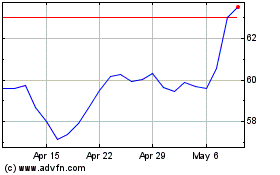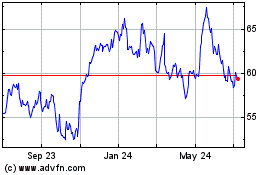By Saabira Chaudhuri
After years of trying and failing to jump-start sales of
alcohol-free beer, the world's largest brewers are expanding their
nonalcoholic offerings with renewed zeal.
Each of the new global Big Three in brewing -- Anheuser-Busch
InBev NV, Heineken NV and Carlsberg A/S -- is investing in new
technology, marketing and distribution for nonalcoholic beers like
Budweiser Prohibition Brew, 0.0% MAXX and Nordic. They are betting
stricter alcohol regulations and a shift toward healthier
consumption will lift sales.
None of the companies breaks out its investments on alcohol-free
beer. But Carlsberg recently outlined plans to, at minimum, double
craft and nonalcoholic beer volumes from 6% to 12% by 2022. And AB
InBev has said at least a fifth of its beer volume world-wide will
be no or low alcohol by the end of 2025, up from 6% currently.
"Nonalcoholic beer is growing three times faster than the
overall beer market and offers some excellent margin
opportunities," says Carlsberg Chief Executive Cees 't Hart earlier
this year.
Brewers earn fatter profit margins from nonalcoholic beer given
the absence of excise tax and the fact that such beers often sell
at a premium to regular beer. Carlsberg figures show an average
gross profit per 100 liters of nonalcoholic beer in Western Europe
that is close to double that of regular beer.
But despite brewers' efforts, the volume of nonalcoholic brews
as a proportion of global beer has stayed roughly flat at around
0.7% for the past decade, according to beverage-industry research
firm Canadean.
Nonalcoholic beer, which is 0.5% alcohol or less, has a fan
following in Muslim-majority markets such as Iran and Indonesia. It
has also gained ground in Spain, where it is commonly drunk with
tapas, and Germany, where it is often consumed after sports
activities, according to market researcher Euromonitor. But in many
large beer markets, including North America and the U.K.,
nonalcoholic beer has failed to gain traction.
Part of the problem is that many everyday drinkers aren't
convinced nonalcoholic beer makes sense.
"It's kind of like nonbeneficial exercise -- why would people
use this if the main benefit doesn't exist?" says Matt Voda, a New
York-based virtual-reality developer who in 2013 did market
research on nonalcoholic beer for Heineken as part of an internship
with the brewer.
Mr. Voda's research during his three months at Heineken showed
nonalcoholic beer was primarily drunk by older people whose doctors
had advised them to cut back on alcohol.
Brewers are working to change this.
At an analyst event Carlsberg hosted last month in Stockholm,
Carlsberg Chief Commercial Officer Jessica Spence says the company
wanted to shift alcohol-free beer from being associated with words
like "compromise," "bad taste," responsible" and "social stigma,"
to being associated with "core beer," "heritage," "craft" and
"innovation."
Carlsberg's advertising shows people drinking its alcohol-free
offerings while hiking, swimming and playing football. The brewer's
nonalcoholic Nordic brand sponsored a run to raise money for cancer
in Denmark last month and says it has similar fitness-focused
activities planned for next year.
Heineken has taken a similar tack, spending on ad campaigns
linking alcohol-free beers to an active lifestyle, a shift from its
previous strategy that mainly touted the functional benefits of
nonalcoholic beer for drivers, pregnant women and the like. It now
has 63 variants of nonalcoholic beer, up from 15 in 2011.
Alcohol-free beer -- which is made either by halting the
conversion of sugars to alcohol early or removing the alcohol after
brewing is complete -- has yet to shrug off a longstanding
reputation for being watery and flavorless.
"The problem for nonalcoholic beer is, if you take the alcohol
out, you're taking some of the flavors out, and if you stop
fermentation you end up with a very sweet product," says David
Ryder, former head brewmaster for MillerCoors.
Now, brewers say technological advancements are helping them
overcome this. AB InBev Brewmaster Charles Nouwen says the company
has come up with specific brewing recipes that help yeast produce
intense beer flavors. It then distills the liquid at a low
temperature to remove the alcohol without losing the beer character
and flavor.
"Our ambition is to close the gap with regular beer, so we can
have both propositions without anyone noticing the difference." Mr.
Nouwen says.
Carlsberg -- which says it has the world's largest collection of
yeasts, at more than 2,500 varieties -- has begun using new yeasts
and bacteria to remove alcohol, as well as new technology to make
cereal- and fruit-based nonalcoholic beer. It has gone beyond
making lagers, launching several alcohol-free wheat beers.
"Until recently there was only a couple of nonalcoholic beers
and they weren't very tasty -- it was almost like water or just not
the right taste -- but with Nordic they've come very close," says
30-year-old Anna Stegger Gemzoe, who drank Carlsberg's Nordic brand
of nonalcoholic beer during her pregnancy last year. In Denmark,
where Ms. Gemzoe lives, Carlsberg Nordic has a 43% share of the
nonalcoholic beer market.
But Carlsberg still has work to do on many of its other
alcohol-free brands, says Liberum analyst Alicia Forry, who sampled
several of the nonalcoholic beers on offer in Stockholm last month.
"They're better than ones I've had in the past," she says, "but
still not something I would pay for."
Write to Saabira Chaudhuri at saabira.chaudhuri@wsj.com
(END) Dow Jones Newswires
November 22, 2016 05:44 ET (10:44 GMT)
Copyright (c) 2016 Dow Jones & Company, Inc.
Anheuser Busch Inbev SA NV (NYSE:BUD)
Historical Stock Chart
From Mar 2024 to Apr 2024

Anheuser Busch Inbev SA NV (NYSE:BUD)
Historical Stock Chart
From Apr 2023 to Apr 2024
